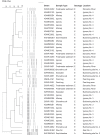Tracking sources of Clostridium botulinum type E contamination in seal meat
- PMID: 28982302
- PMCID: PMC5645764
- DOI: 10.1080/22423982.2017.1380994
Tracking sources of Clostridium botulinum type E contamination in seal meat
Abstract
Botulism in Nunavik, Quebec is associated with the consumption of aged marine mammal meat and fat. The objective was to identify meat handling practices presenting a risk of contamination of seal meat with C. botulinum. Potential sources of contamination were assessed through interviews with igunaq producers from five communities of Nunavik. These sources were verified by detection and isolation of C. botulinum from igunaq prepared in the field from seal carcasses. Interviews indicated practices presenting a risk for contamination included: placing meat or fat on coastal rocks, using seawater for rinsing, and ageing meat in inverted seal skin pouches. Although the presence of C. botulinum type E spores was detected in only two of 32 (6.3%) meat or fat samples collected during the butchering process, two of four igunaq preparations from these samples contained type E botulinum toxin. Analysis of C. botulinum type E isolates recovered from these preparations indicated that shoreline soil may be a source of contamination. Seal meat and fat may be contaminated with C. botulinum type E during the butchering process. Measures can be adopted to reduce the risks of contamination in the field and possibly decrease the incidence of type E botulism in Nunavik.
Keywords: Arctic; Clostridium botulinum; environment; marine mammal; meat handling; spore.
Conflict of interest statement
No potential conflict of interest was reported by the authors.
Figures

Similar articles
-
Distribution of Clostridium botulinum type E strains in Nunavik, Northern Quebec, Canada.Appl Environ Microbiol. 2013 Jan;79(2):646-54. doi: 10.1128/AEM.05999-11. Epub 2012 Nov 16. Appl Environ Microbiol. 2013. PMID: 23160120 Free PMC article.
-
[Quick recovery, after administration of a botulinic antitoxin serum in two patients presenting with botulism].Med Mal Infect. 2011 Jan;41(1):44-6. doi: 10.1016/j.medmal.2010.09.010. Epub 2010 Nov 19. Med Mal Infect. 2011. PMID: 21094008 French. No abstract available.
-
Observations on the distribution and ecology of Clostridium botulinum type E in Alaska.Can J Microbiol. 1975 Jun;21(6):920-6. doi: 10.1139/m75-136. Can J Microbiol. 1975. PMID: 1097074
-
Human pathogens in marine mammal meat – a northern perspective.Zoonoses Public Health. 2014 Sep;61(6):377-94. doi: 10.1111/zph.12080. Zoonoses Public Health. 2014. PMID: 24344685 Review.
-
Visible contamination on animals and carcasses and the microbiological condition of meat.J Food Prot. 2004 Feb;67(2):413-9. doi: 10.4315/0362-028x-67.2.413. J Food Prot. 2004. PMID: 14968981 Review.
Cited by
-
Clostridium botulinum type C, D, C/D, and D/C: An update.Front Microbiol. 2023 Jan 5;13:1099184. doi: 10.3389/fmicb.2022.1099184. eCollection 2022. Front Microbiol. 2023. PMID: 36687640 Free PMC article. Review.
-
Public Health Risk Associated with Botulism as Foodborne Zoonoses.Toxins (Basel). 2019 Dec 30;12(1):17. doi: 10.3390/toxins12010017. Toxins (Basel). 2019. PMID: 31905908 Free PMC article. Review.
-
Better understanding of food and human microbiomes through collaborative research on Inuit fermented foods.Microbiome Res Rep. 2022 Jan 24;1(1):5. doi: 10.20517/mrr.2021.06. eCollection 2022. Microbiome Res Rep. 2022. PMID: 38089063 Free PMC article.
-
Development and Characterization of Monoclonal Antibodies to Botulinum Neurotoxin Type E.Toxins (Basel). 2019 Jul 13;11(7):407. doi: 10.3390/toxins11070407. Toxins (Basel). 2019. PMID: 31337022 Free PMC article.
References
-
- Austin JW, Leclair D. Botulism in the North: a disease without borders. Clin Infect Dis. 2011;52:593–594. - PubMed
Publication types
MeSH terms
LinkOut - more resources
Full Text Sources
Other Literature Sources
